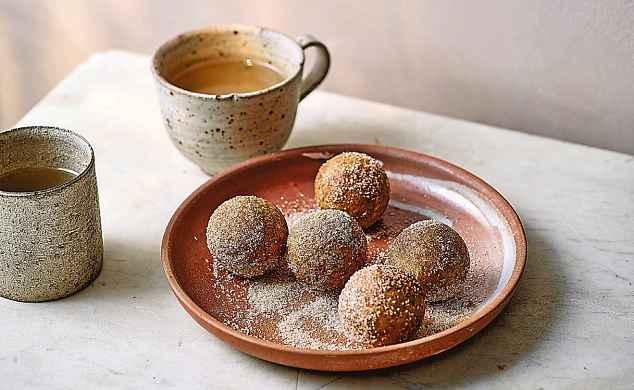
2 minute read
Sweet rice doughnuts –makes 20
completely incorporated, beforeadding the tomatoes. Let it simmer for afurther 10 minutes.
4. Meanwhile, bring apan of well-salted water to the boil. Slice the tofu into two long blocks about 4cm wide. Gently drop the tofu blocks into the boiling water and poach them for fiveminutes overa low heat. Carefully drain the tofu and cool slightly, taking careofthe hot steam. When they’recooled enough to handle, cut each block into 2cm thick slabs.
5. By now, the kimchi should be ready. Checkthe seasoning and add apinch moresalt or sugar,ifnecessary. To finish, stir in thesesame oil and white sesame seeds. Reservesome of the spring onion for garnish, if you like, and add the remainder
6. To serve, transfer the sliced tofu slabs onto aserving platter or individual plates, along with the sautéed kimchi either on top or on the side. Topwith the black sesame seeds and reserved spring onion.
“This is apopular old-school Korean snack, which deserves morerecognition –itisnot well known outside of Korea,” says Su. “This could be partly to do with the fact that, moreoften than not, most recipes call for ‘wet’ rice flour: freshly milled rice flour made from pre-soaked rice. In traditional baking, wetrice flour was preferredbecause of its excellence in retaining moisture, resultinginmore moist and chewier rice cakes that keep well. Nowadays, morerecipes are being developed using dry flour for the convenience of home baking.”
Ingredients
250g glutinous rice flour
50g plain flour
½tsp baking powder
½tsp bicarbonate of soda
40g golden caster sugar
½tsp fine sea salt
30g unsalted butter,melted
80ml warm full-fat milk
150ml hot water,about 80°C
Vegetable oil, for deep frying
For the cinnamon sugar
2tbsp golden caster sugar
½tsp ground cinnamon
Method
1. Sift both flours, the baking powder and bicarbonate of soda into alarge mixing bowl. Add the sugar and salt.
2. In apourable and heatproof jug, combine the melted butter and warm milk. Stir this into the flour mix, using a wooden spoon or chopsticks. Gradually pour in the hot water and continue to mix until it resembles rough crumbs. Do this in afew stages as your flour may not need as much water,ormight need atouch more, than stated here.
3. When the dough is cool enough to handle, start bringing the ingredients together by gently kneading until the dough feels supple and the surface is smooth.
4. Place the dough in areusable plastic bag or wrap in clingfilm. Rest in the fridge for at least one hour or overnight.
5. After the dough has rested, divide it into four equal-sized portions, so you havea moremanageable volume to work with. Work one piece at atime, keeping theremaining dough covered. Shape the dough roughly into alog, then divide it into fivesmall golf-ball-sized pieces. The textureofthe dough may feel unusual and alittle crumbly. Don’t worry if this happens –just squeeze the dough firmly to shape.
6. Combine the sugar and cinnamon together in abowlorarimmed roasting pan. Haveanother plate or dish ready lined with some kitchen paper
7. Fill asaucepansuitable for deep-frying with vegetable oil. It should be filled deep enough to submerge the dough balls but no morethan three-quarters full. Heat to 160°C. If you don’t havea thermometer, acubeofbread should brownin12 seconds. When it reaches160°C, turn off the heat and carefully lowera few of the dough balls into the pan, making sureyou don’t overcrowdthe pan. Keep the heat off for two minutes. After two minutes, the dough will start to move andfloat alittle.
8. Turn theheatback on and maintain the temperate at 160°C. Frythe dough balls for fiveminutes, making suretogently push them down with aheatproof sieveor wireskimmer,asthey will continuously float up. After fiveminutes, the doughnuts should appear golden brownand cooked through. Transfer to theplate lined with kitchen paper to absorb the excess oil. Continue with the remaining dough balls.
9. When all the batches arecooked, roll them in the cinnamon sugar while hot and serveimmediately.










